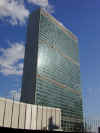 |
New York
Architecture Images- Midtown United Nations Headquarters |
|
architect |
United Nations Board of Design, headed by Wallace K. Harrison, overall composition by Le Corbusier |
|
location |
United Nations Plaza (First Avenue bet. 42nd and 48th Streets) |
|
date |
1947-53 |
|
style |
International Style II |
|
construction |
New York's earliest glass curtain wall, 38 stories or 544 feet tall |
|
type |
Office Building |
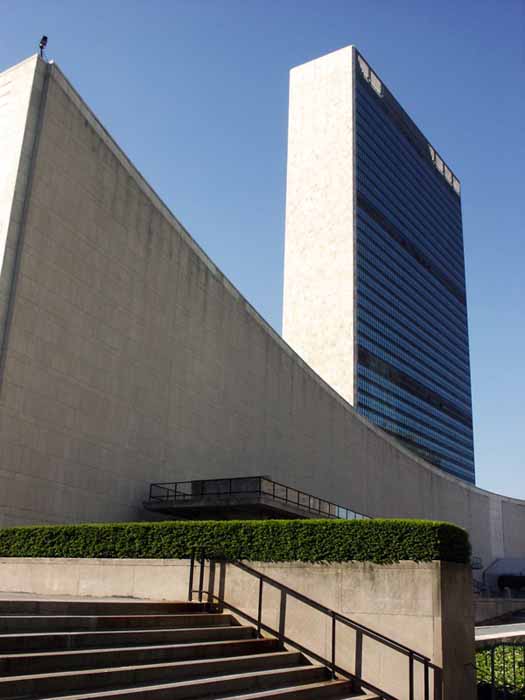 |
|
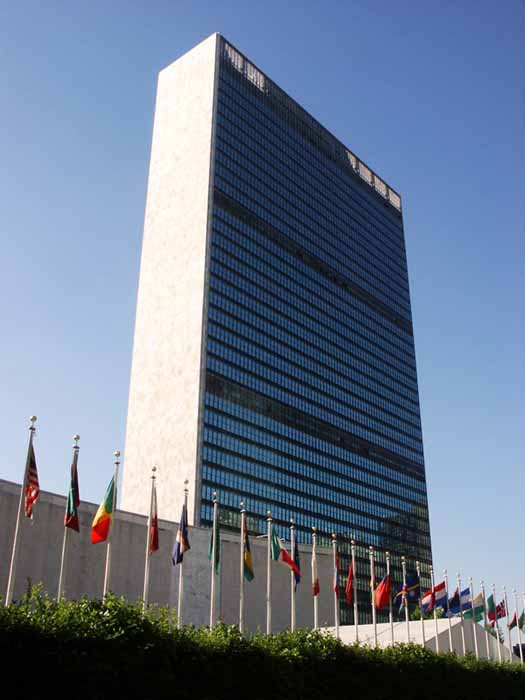 |
|
| Image- with special thanks to Rick Stasel | |
|
|
     |
|
images |
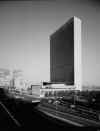 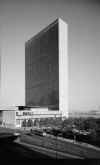 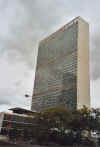  |
      |
|
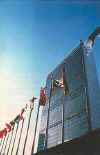  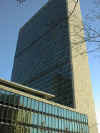 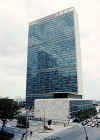 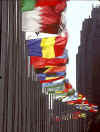 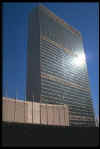 |
|
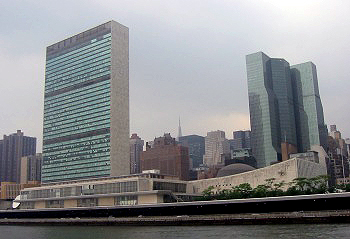 |
|
| United Nations Headquarters in New York City, viewed from the East River. | |
.jpg) |
|
| Interior of the General Assembly. | |
.jpg) |
|
| Dag Hammarskjöld in front of UN headquarters. | |
.jpg) |
|
| Interior of the Security Council chambers. | |
|
Built for an important international organization, this modern complex helped revitalize New York City at the end of the second world war. Located between First Avenue and the East River at the terminus of 42nd Street, the 18-acre site was donated to the newly-formed United Nations by John D. Rockefeller, Jr. To facilitate access to the UN site, Robert Moses (then the city's construction coordinator) diverted traffic from First Avenue. The centerpiece of the UN complex is the Secretariat, an International Style skyscraper based on plans by Le Corbusier, one of the most well-known modern architects. The actual design for the building was carried out by an international team of architects under the direction of Wallace Harrison. This 39-story building was the first major International Style building to be constructed in New York. Typical of the International Style are its simple, geometric form, the absence of historical references, and its glass curtain wall. The architects' use of green glass, marble, and bands of metal detailing are modifications to the modern architectural vocabulary. Located on a highly visible site and surrounded by open spaces, this tower is the only freestanding skyscraper in New York. The International Style, which originated in Europe, had social and political implications as it was frequently associated with progressive, reform-oriented architects and patrons. Here it symbolizes the international, benevolent functions of the UN but its soaring height makes a specific reference to America and to New York in particular. Although the building makes an interesting formal statement, it is not necessarily functional. The narrow floors are too cramped for the office spaces and its large expanses of glass have caused problems with temperature regulation inside the building. Despite these problems, this building helped to revitalize Midtown and the neighborhoods along the East River during a period when it was most needed. Is the most prominent member of the United Nations Organization (first assembly in 1946) building complex on an 18-acre site stretching along the East River from 42nd to 48th Streets. The organization had been searching for a site to locate to, and when developer William Zeckendorf's plans for the so-called "X City" to these East River blocks he had collected fell through, the site was proposed as a home for the U.N.. As the city was unable to purchase the site itself, John D. Rockefeller, Jr. bought the land for the complex for $8.5 million and donated it to the city in December 1945. An international committee of architects, called the United Nations Board of Design, was assembled in 1947 and consisted of ten architects (including Brazilian Oscar Niemeyer and Swede Sven Markelius) and was assisted by numerous consultants. Work on the plans was started in January 1947. Of individual architects' proposals, that by Le Corbusier, representing France, was chosen as the basis for further design. His "scheme 23A" from March 1947 included, among the placement and massing of the actually completed buildings (like the Secretariat as a high-rise slab), also an (unrealized) east-west slab on the north end of the site. Razing of the site was begun in July 1947 and ground for the Secretariat building broken on September 14, 1948. The cornerstone was laid on October 24, 1949 and the Secretariat was completed in spring 1950. The whole complex was ready by 1952. Despite the strong criticism against its scale (as opposed to General Assembly and Conference buildings) and its interior design, the 39-storey, 154 m tall Secretariat building was nevertheless an impressive modernist landmark, and it influenced commercial building for years after its completion. The east and west facades' blue-green-toned Thermopane windows were chosen because they lessened the heating effect of the sun, thus reducing the need for a more effective air-conditioning. The curtain wall of the building is truly all-glass, as also the spandrels between the window rows of the floors are of glass, only painted black on the inside surface. Although Le Corbusier opposed this arrangement and wanted to use normally opening windows along with brise soleil awnings as a guard against sunheat -- related to the fixed metal rod screens that have become so commonplace in the 1990s -- the curtain wall was to epitomize the whole skyscraper design from that point on. The windowless north and south ends of the Secretariat are clad in marble plates from Vermont. The glass walls are interrupted by air-conditioning intake grilles on 6th, 16th, 28th and 39th floors, extending the whole width of the facade (image). The structural columns form 28 feet (8.5 meters) wide bays along the outer wall and the glass walls are cantilevered 0.8 meters from the column line to enable an uninterrupted curtain wall. On the 38th floor of the building are the UN Secretary General's offices. At the top is a high aluminium grille to conceal the equipment on the roof. Bronze sculpture Single Form (1962-63) by Barbara Hepworth stands outside the Secretariat. The United Nations is seeking ways to make extensive repairs and updates to the building that is plagued by asbestos, lead paint and concrete falling off, as well as inefficient ventilation and windows and a lack of fire sprinklers. Renovation could cost $1 billion and possibly require the construction of a new office tower to the south of 42nd Street to house the Secretariat's activities meanwhile. |
|
|
How to visit
The United Nations Headquarters is on First Avenue between 42nd Street and 48th Street. The Visitors' Entrance is located on First Avenue at 46th Street. Subway: number 4,5,6 or 7 trains to Grand Central Station; walk on 42nd Street to First Avenue. Buses: M15, M27, M42, or M104 Parking: No facilities. The building is open to the public, with
guided tours provided. For detailed directions, times and prices, visit
www.un.org/tours
or call |
|
|
The United Nations Headquarters is a distinctive complex in New York City
that has served as the headquarters of the United Nations since its
completion in 1950. It is located in the Turtle Bay neighborhood, on the
east side of Midtown Manhattan, on spacious grounds overlooking the East
River. Though it is in New York City, the land occupied by the United
Nations Headquarters is considered international territory, and its
borders are First Avenue west, East 42nd Street south, East 48th Street
north and the East River east. FDR Drive passes underneath the
Conference Building of the complex. The United Nations Headquarters were constructed in New York City in 1949 and 1950 beside the East River, on seventeen acres of land purchased from the foremost New York real estate developer of the time, William Zeckendorf. This purchase was arranged by Nelson Rockefeller, after an initial offer of placing it on the Rockefeller family estate of Kykuit was rejected as being too isolated from Manhattan. The $8.5 million purchase was then funded by his father, John D. Rockefeller, Jr., who donated it to the City. The lead architect for the building was the real estate firm of Wallace Harrison, the personal architectural adviser for the family. Planning and construction Rather than announce a competition for the design of the facilities for the headquarters, the UN decided to commission a collaborative effort among a multinational team of leading architects. American architect Wallace Harrison was named the director of planning, and a board of design consultants was nominated by member governments. The board consisted of N.D. Bassov of the Soviet Union, Gaston Brunfaut (Belgium), Ernest Cormier (Canada), Le Corbusier (Switzerland), Liang Ssu-cheng (China), Sven Markelius (Sweden), Oscar Niemeyer (Brazil), Howard Robertson (United Kingdom), G.A. Soilleux (Australia), and Julio Villamajo (Uruguay). The committee considered 50 different designs before arriving at a decision. The basis for the final design was based on Le Corbusier's design, known as "Scheme 23A." Bound by such constraints as the East River Drive (later the Franklin D. Roosevelt East River Drive) and the East River, it became necessary to build a high-rise office building for the secretariat. The 38-story Secretariat Building was controversial in its time but became a modernist landmark. Its characteristic east-west walls were fully covered with thermopane glass designed to absorb heat from sunlight, except for air intakes on the 6th, 16th, 28th and 38th floors. The north-south walls are covered with Vermont marble. Per an agreement with the New York City government, the buildings meet some but not all local fire safety and building codes. The construction of the headquarters was financed by an interest-free loan of $65 million made by the United States government.[2] The UN's founders believed that decolonization was many decades away; accordingly, they instructed the architects of the new UN buildings in New York to allow for an expansion to only "some 70 members."[3] Proposed alternatives San Francisco, Chicago, Philadelphia, Flushing Meadows-Corona Park in Queens, and even the Black Hills of South Dakota were all proposed as sites for the United Nations Headquarters before Manhattan was finally decided upon. It was later revealed that France, the UK and the Netherlands voted against situating the headquarters in the United States.[4] In 1945-6 London hosted the first meeting of the General Assembly in Methodist Central Hall, and the Security Council in Church House. The third and sixth General Assembly sessions, in 1948 and 1951, met in the Trocadéro in Paris. Prior to the construction of the current complex, the UN was headquartered at a temporary location in Lake Success, New York, an eastern suburb of New York City on Long Island. The Security Council has also held sessions on what was then the Bronx campus of Hunter College (now the site of Lehman College).[5] Prior to the choice of the site in New York City, Navy Island near Niagara Falls in Ontario, Canada was proposed as an alternative headquarters for the United Nations.[6] An international committee pitched the site as the "World Peace Capital" over 1945 and 1946. The island was considered to be an ideal location as it lay on the boundary of two bordering countries of a peaceful status. It was proposed that Navy Island would be ceded to the United Nations as long as the headquarters remained, and to revert to the Canadian government should the UN move. The proposal was ultimately turned down in favor of the current site in New York City. Since the Headquarters buildings are in need of repair, it has been suggested that a new temporary site be created at the old Lake Success location. Brooklyn has also been suggested as a temporary site.[7] Another alternative for a temporary headquarters or a new permanent facility is the World Trade Center site.[8] The Canadian government, along with provincial and municipal authorities, have proposed Montreal as a site to move the headquarters; a former docklands site has been earmarked and preliminary drawings made [6]. Montreal is seen as a good fit for the organization, not least due to the English/French bilingualism to be found in both UN staff and the city [7]. International character The site of the United Nations Headquarters has extraterritoriality status, typical of embassies.[9] This affects some law enforcement where UN rules override the laws of New York City, but does not give immunity to crimes that take place there. In addition, the United Nations Headquarters remains under the jurisdiction and laws of the United States, although a few members of the UN staff have diplomatic immunity and so cannot be prosecuted by local courts unless the diplomatic immunity is waived by the Secretary-General. In 2005, Secretary-General Kofi Annan waived the immunity of Benon Sevan, Aleksandr Yakovlev, and Vladimir Kuznetsov in relation to the Oil-for-Food Programme. All have been charged in the U.S. Federal Court of New York, except for Kofi Annan's own son, also implicated in the scandal. Benon Sevan later fled the U.S. to Cyprus, while Aleksandr Yakovlev and Vladimir Kuznetsov decided to stand trial. The currency in use at the United Nations headquarters' businesses is the U.S. dollar. English and French are the working languages of the United Nations, i.e., most of the daily communication within secretariat and most of the signs in the UN headquarters building are in French and English. The complex has a street address of 760 United Nations Plaza, New York, NY 10017, USA. For security reasons, all mail sent to this address is sterilized, so items that may be degraded should be sent by courier.[10] The United Nations Postal Administration issues stamps, which must be used on stamped mail sent from the building. Journalists, when reporting from the complex, will not use "New York" as the identification of their location in recognition of the extraterritoriality status.[11] Structures The complex includes a number of major buildings. While the Secretariat Tower is most predominantly featured in depictions of the headquarters, it also includes the domed General Assembly Hall, the Dag Hammarskjöld Library, as well as the Conference and Visitors Center, which is situated between the General Assembly and Secretariat buildings, and can be seen only from FDR Drive or the East River. Just inside the perimeter fence of the complex stands a line of flagpoles where the flags of all 192 UN member states, plus the U.N. flag, are flown in English alphabetical order.[12] Art at the United Nations Let Us Beat Swords into Plowshares statue at United Nations headquarters.Main article: United Nations Art Collection The complex is also notable for its gardens and outdoor sculptures. Iconic sculptures include the "Knotted Gun," a gift from the Luxembourg government[13] and "Let Us Beat Swords Into Plowshares," a gift from the then-Soviet Union.[14] The latter sculpture is the only appearance of the "swords into plowshares" quotation, from Isaiah 2:4, within the complex. Contrary to popular belief, the quotation is not carved on any UN building.[15] Rather, it is carved on the "Isaiah Wall" of Ralph Bunche Park across the street. A piece of the Berlin Wall also stands in the U.N. garden. Other prominent artworks on the grounds include a Marc Chagall stained glass window memorializing the death of Dag Hammarskjöld,[16] the Japanese Peace Bell which is rung on the vernal equinox and the opening of each General Assembly session,[17] a Chinese ivory carving made in 1974 (before the ivory trade was largely banned in 1989),[18] and a Venetian mosaic depicting Norman Rockwell's painting The Golden Rule.[19] Other buildings While outside of the complex, the headquarters also includes two large office buildings that serve as offices for the specialized agencies of the organization, such as UNDP. These buildings, known as DC-1 and DC-2 are located at 1 and 2 UN Plaza respectively. There is also an identification office at the corner of 46th Street, inside a former bank branch, where pre-accredited diplomats, reporters, and others receive their grounds pass. UNICEF House (3 UN Plaza) and the UNITAR Building (807 UN Plaza) are also part of headquarters. However, the Church Center of the United Nations (777 UN Plaza) is a private building owned by the Methodist Church as an interfaith space housing the offices of several non-governmental organizations. Renovation plans In recent years, however, the headquarters buildings have come to need extensive renovation, including the need to install sprinklers, fix leaks, and remove asbestos. A renovation plan was announced in 2000 involving the building of a temporary headquarters on what is now a playground (Robert Moses Park) across the street from the current facility. Once renovations were finished, the temporary building would be used to ease overcrowding at the DC-1 and DC-2 However, due to the refusal of the federal and New York state governments to fund the project, little has been accomplished as of 2006. On July 28, 2007 it was announced the complex will undergo a $1 billion renovation starting in the fall. Swedish firm Skanska AB won a bid to overhaul the buildings which will include the Conference, General Assembly and Secretariat buildings. The renovations, which will be the first since the complex opened in 1950 are expected to take about 7 years to complete. When completed the complex is also expected to be more energy efficient.[20][21][22][23][24] Officials hope the renovated buildings will achieve a LEED Silver rating, although they concede that the delay in construction will result in a projected 7.5% inflation rate in the cost of materials and labor over the course of the project.[25] Depictions in popular culture Hallway in the General Assembly building. The General Assembly chamber is to the right.Due to its role in international politics, the United Nations Headquarters is often featured in movies and other pop culture. Movies in which the headquarters buildings are major settings include North by Northwest, Live and Let Die, The Art of War, U.S. Marshals, Batman (1966 film), The Glass Wall, The Second Renaissance and The Peacemaker. But the only film actually shot on location in the UN headquarters is The Interpreter, filmed with the consent of the Secretary-General.[26] The cover of the Megadeth album "Peace sells... But who's buying?" Depicts the U.N. headquarters lying in ruins with the sign "for sale". In the book World War Z, the United Nations Headquarters is moved to the USS Saratoga. The headquarters are featured in the video games Civilization and SimCity 3000. The Marc Chagall stained glass wall was the subject of a souvenir sheet of U.N. postage stamps in 1967. A painting from the 1960s depicts a figure of Jesus that is about the same height as the Secretariat building, who knocks on the stained glass wall as if seeking entry.[27] In The Pink Panther Strikes Again, chief inspector Dreyfus uses a special laser cannon to make the building vanish, as a power demonstration to get chief inspector Clouseau. In 7th Son: Destruction, an emergency escape bullet train called EvacSys was used as a major plot point within the trilogy of Podiobooks. In Half-Life 2, UN headquarters is damaged by the Combine forces. In Tycoon City: New York UN Headquarters allowed to be build as a site. Public gatherings Protests, demonstrations, and other gatherings directly on First Avenue are rare. Some gatherings have taken place in Ralph Bunche Park, but it is too small to accommodate large demonstrations. The closest location where the New York City Police Department usually allows demonstrators is Dag Hammarskjöld Plaza at 47th Street and First Avenue, one block away from the visitors' entrance, four blocks away from the entrance used by top-level diplomats, and five blocks away from the general staff entrance. Excluding gatherings solely for diplomats and academics, there are a few organizations which regularly hold events at the UN. The United Nations Association of the United States of America (UNA-USA), a non-governmental organization, holds an annual "member's day" event in one of the conference rooms. Model United Nations conferences sponsored by UNA-USA, the National Collegiate Conference Association (NCCA/NMUN), and the International Model UN Association (IMUNA/NHSMUN) hold part of their sessions in the General Assembly chamber. |
|